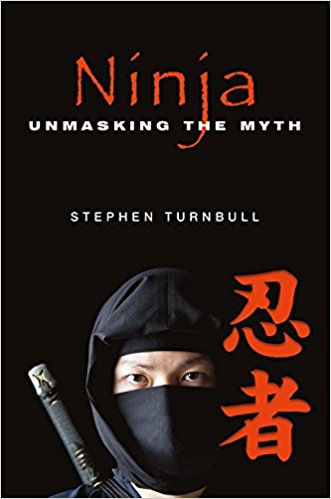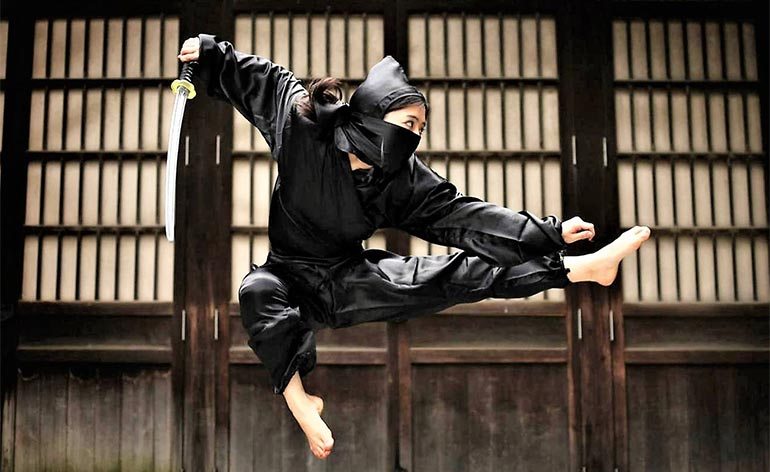Books: The Ninja Myth
March 25, 2018 · 2 comments
By Jonathan Clements.
 I’d been sceptical for a long time, but I didn’t step out of the shadows until about ten years ago. I hesitated for a long while because I was sure I had to be missing something. Surely that many people could not all be fooled by the same fake news…? But by 2007, I was ready to state that there was no such thing as ninja. The burden of proof, I decided, should lay on those who said they did exist, not those who said they didn’t.
I’d been sceptical for a long time, but I didn’t step out of the shadows until about ten years ago. I hesitated for a long while because I was sure I had to be missing something. Surely that many people could not all be fooled by the same fake news…? But by 2007, I was ready to state that there was no such thing as ninja. The burden of proof, I decided, should lay on those who said they did exist, not those who said they didn’t.
 Stephen Turnbull and I have been circling around the ninja myth for more than twenty-five years, often on opposite sides. We first met at Leeds University where I was an undergraduate and he was starting his doctorate, and we were both, I think, inspired by the sight of our colleague Samuel Jacobs and his struggle to make sense of the history of ninjutsu. Sam’s horrified discovery of what would now be called ninjutsu’s “invented tradition” would eventually propel me into writing my Brief History of the Martial Arts, and Turnbull into questioning his own earlier work. As he himself admitted, the younger Turnbull was something of a samurai fanboy, propelled almost accidentally into the field by his enthusiasm for war-gaming, and by the absence of any published material in English for the general reader. It’s only as an older, wiser man that he was confronted with true historical rigour, source-critical analysis and the possibility that the Japanese might have been involved in a long, consensual hallucination about invisible assassins. By then, it was too late. Turnbull had literally written the book on the historical ninja, and with fist-gnawing embarrassment, had come to realise that it was built on doubtful foundations.
Stephen Turnbull and I have been circling around the ninja myth for more than twenty-five years, often on opposite sides. We first met at Leeds University where I was an undergraduate and he was starting his doctorate, and we were both, I think, inspired by the sight of our colleague Samuel Jacobs and his struggle to make sense of the history of ninjutsu. Sam’s horrified discovery of what would now be called ninjutsu’s “invented tradition” would eventually propel me into writing my Brief History of the Martial Arts, and Turnbull into questioning his own earlier work. As he himself admitted, the younger Turnbull was something of a samurai fanboy, propelled almost accidentally into the field by his enthusiasm for war-gaming, and by the absence of any published material in English for the general reader. It’s only as an older, wiser man that he was confronted with true historical rigour, source-critical analysis and the possibility that the Japanese might have been involved in a long, consensual hallucination about invisible assassins. By then, it was too late. Turnbull had literally written the book on the historical ninja, and with fist-gnawing embarrassment, had come to realise that it was built on doubtful foundations.
After I openly questioned the validity of the ninja in my Brief History of the Samurai, a British publisher asked me if I would write a book debunking such myths. I declined, on the grounds that I didn’t want to waste a year of my career clearing up someone else’s mess. Ninjutsu seemed to me to be a pointless redoubt of charlatanry, defended only by the ignorant and the invested. Which is why I am so pleased not only to see Turnbull fixing a problem that is at least partly of his own making, but doing so with such a good-natured attitude towards the apologists. He has, he admits, feet in both camps of the ninja phenomenon, and regards himself as in good company, noting that even the professor of ninja studies at Mie University seems to flip-flop between breathless nonsense and sharp investigation.
Ninja: Unmasking the Myth is a brave book. With a scientific sense of objectivity, Turnbull tears down an edifice that he himself helped to build, shining the harsh glare of academic rigour on his earlier work. In doing so, he uncovers some striking facts about the evolution of the ninja, not the least that the word doesn’t even occur in Japanese-English dictionaries until 1974. But, just as Tolkien once lamented the post-modernists who would wreck the tall tower from which a historian could once see the sea, Turnbull is unable to resist looking around him at the bricks. Because all those stories had to come from somewhere. Someone had to be involved in the dirty tricks of several centuries of samurai warfare. Picking through the rubble, he starts to uncover some intriguing mysteries, such as the appearance of the word xinobi in a Portuguese Jesuit’s dictionary from the early 1600s, and stories of backstabbing and intrigue that are a world away from the supposedly noble samurai.
He centres his investigations on the twinned provinces of Iga and Koka, long associated with specialists in espionage, although truly old records have all been conveniently lost to war and fire. Indeed, Turnbull uncovers enough allusions to dirty tricks that I suspect many ninja fans will hail his book as further proof of their own theses. The holes he delineates in the historical record mark out the samurai as their own worst enemies – unwilling to take the credit for “dishonourable” espionage operations, they left vast gaps that later commentators have filled with imaginary superheroes. Turnbull’s account of actual events come heavy with Japanese-language citations and annotations – in order to adequately de-ninja the record, he is forced to bombard the reader with the sheer mundanity of the actual military operations. But I see no other way of properly debunking ninja myth than by such means, so we spend several chapters of this “ninja” book going through accounts of samurai warfare that demonstrably have no ninja in them.
 Once the wars are done, and the samurai settle in for their long decline during the Tokugawa period, Turnbull points to the paranoia likely to afflict the masters of a police state. Everyone frets about Christian fifth columnists and undercover padres; everyone is jumpy about the prospects of a peasant rebellion. Meanwhile, the samurai are turned into jumped-up accountants and administrators, devouring lurid potboilers about the glory days, determined to present those samurai as self-styled honourable men who would not dream of stabbing someone in the back. But it’s in the post-war period that Turnbull really comes into his own, chronicling the sudden spring from the shadows as ninja are taken up by left-wing authors and children’s entertainers in search of a new angle on the samurai era. The trouble, as they say, when people believe in nothing, is that people will believe anything.
Once the wars are done, and the samurai settle in for their long decline during the Tokugawa period, Turnbull points to the paranoia likely to afflict the masters of a police state. Everyone frets about Christian fifth columnists and undercover padres; everyone is jumpy about the prospects of a peasant rebellion. Meanwhile, the samurai are turned into jumped-up accountants and administrators, devouring lurid potboilers about the glory days, determined to present those samurai as self-styled honourable men who would not dream of stabbing someone in the back. But it’s in the post-war period that Turnbull really comes into his own, chronicling the sudden spring from the shadows as ninja are taken up by left-wing authors and children’s entertainers in search of a new angle on the samurai era. The trouble, as they say, when people believe in nothing, is that people will believe anything.
Turnbull sets the rise of the ninja phenomenon within its true historical context, related less to the skulduggery of 15th-century warfare than to post-modern pulp entertainment and wilful wrecking of the establishment record. He also grapples with the inevitable issue of modern materiality — there might have been no such thing in times past, but there are people today who study a martial art they call ninjutsu. They can prove to you that they’re real by punching you in the face. But historical ninja, like The Usual Suspects’ Keyser Soze, derive their greatest strength from being disavowed. The more that people like me protested there was no evidence, the more the tin-foil hat brigade claimed that this, too, was evidence of a conspiracy and a cover-up. Turnbull subjects ninja lore to ironclad diligence, nowhere more incisively than in his chapter “A Star is Born”, which chronicles the development of the legendary shuriken, from misreadings and fudges of genuine historical sources, to spurious claims in 20th century manuals, to its iconic status today as the centre of the ninja’s arsenal, largely through its appearance in movies. He concludes by relating ninja to “holy land” tourism – when Nerima wants to set itself up as a place of pilgrimage for anime fans, and Kagawa wants to be known as the home of a certain kind of noodle, is it any wonder that Iga tried to brand itself with tourists as the Ninja City?
The result is a valuable book that deftly steers through confusing and controversial materials. Even ninja apologists will feel that honour has been served. Turnbull admirably exposes and investigates the “careless retrospective interpretations” of the 20th century, but in doing so, manages to reclaim the historical shinobi.
Jonathan Clements is the author of A Brief History of the Martial Arts.
JD
March 25, 2018 10:40 am
So, if the "Ninja" don't exist, why was the myth created? Was it just to frighten (Western) people, or was there some other ulterior motive - possibly an even more sinister one?
Jonathan Clements
March 25, 2018 11:47 am
Because the samurai dominated 800 years of Japanese history and were then proclaimed persona non grata in 1945. A faction of left-wing writers started celebrating the unsung heroes of the samurai era, whom they decided were humble peasants who never got the credit they deserve. See here: https://schoolgirlmilkycrisis.com/2014/11/12/clap-your-hands-if-you-believe-in-ninja/ and here http://www.mangauk.com/men-in-black/ .